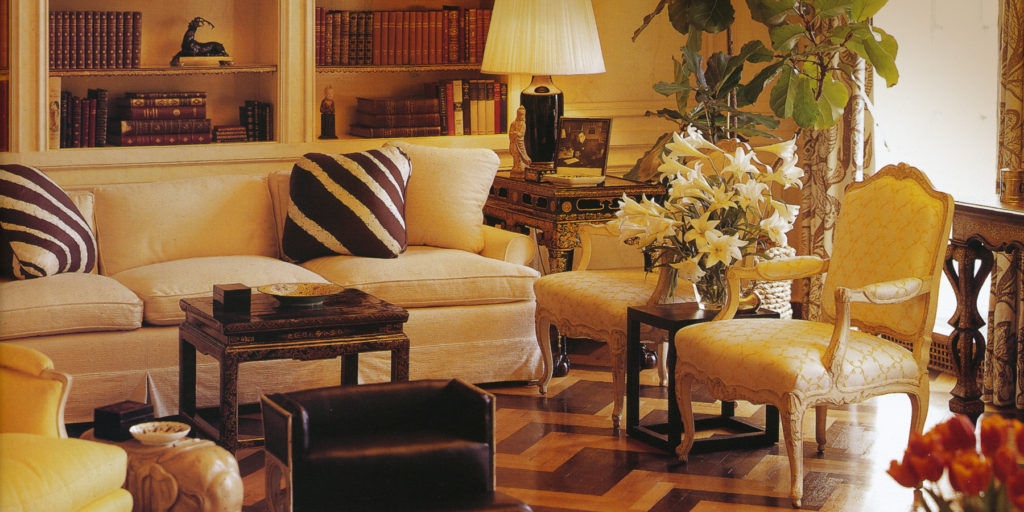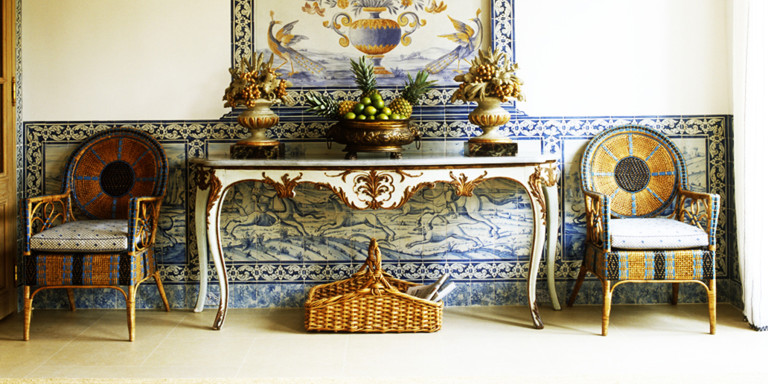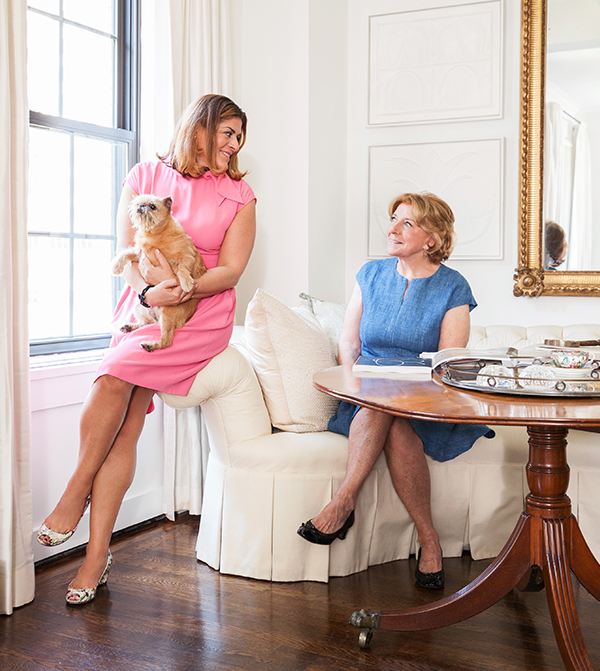
April 4, 2012The famously publicity-averse designer sat for Fernando Bengoechea in 2004. Portrait by © Fernando Bengoechea, courtesy of Beateworks/Corbis
When Albert Hadley died last week at the age of 91, America lost its preeminent interior designer. And that’s no mere hyperbole. Indeed, it’s the subtitle of Adam Lewis’s 2005 biography, Albert Hadley: The Story of America’s Preeminent Interior Designer (Rizzoli), which lays out in words (many by the famously discreet Hadley himself) and pictures the tale of this preternaturally gracious, charming, generous and, oh yes, gifted Tennessee boy’s life and brilliant career.
Beginning with his studies at Parsons (where he would eventually teach), throughout his groundbreaking, 33-year partnership with WASP-doyenne Sister Parish and, following Mrs. Parish’s death in 1994, through the exciting work he did in his eighth and ninth decades (which seemed to simultaneously draw on historical precedents and reach into the future), Hadley never failed to deploy his perpetually modern, “completely American, architectural approach, and a perfect sense of scale,” according to Annette de la Renta, in her foreword to Lewis’s book. “Where lesser talents seem always to want to add,” continues de la Renta, a repeat client (and as the daughter of Parish-Hadley habitué Jane Engelhard, a second-generation one, at that), “Albert subtracts.”
But he also multiplied, in terms of the talents he inspired, mentored and nurtured over the years. The pantheon seems overstuffed with designers who passed through Parish-Hadley’s doors, including such luminaries as Bunny Williams, David Easton, Mark Hampton, Mariette Himes Gomez, Thomas Jayne, David Kleinberg . . . the list goes on and on.
His client roster is equally stellar: from Brooke Astor (her red library is one of the iconic American rooms) to President John F. and Jacqueline Kennedy, William and Babe Paley, Gordon and Ann Getty, Henry and Louise Grunwald, Mike Nichols and Diane Sawyer. In paying tribute, Introspective has turned to several of the countless people whom he touched over the years and asked them to share their impressions and memories of Albert Hadley, a soaring talent and a true gent.

Hadley’s own dramatic New York living room. Photo by Dennis Krukowski, image © Albert Hadley, by Adam Lewis, Rizzoli New York, 2005

A view of Hadley’s sitting room. Photo by Kerri McCaffety, courtesy of Thomas Jayne. © Fernando Bengoechea/Beateworks/Corbis
Albert was like Peter Pan. He never grew old. No one was more knowledgeable about the history of design and no one was more modern. It was this combination that always made magic. His work will be studied for ages and he will live with me forever.
— Bunny Williams, interior designer (worked at Parish-Hadley from 1967 to 1988)
Albert Hadley’s influence on the design world resulted solely from his example. He did not seek publicity although his work appeared in many publications. His work was classic with a sly punch that made it a knockout. His range went beyond classicism when he chose and when his clients agreed. He had no interest in being trendy. His work always seemed effortless. Only a designer as brilliant as Albert could make that magic.
— Paige Rense Noland, former editor in chief Architectural Digest
I had been working very closely with Mr. Hadley during my first year at his firm and had apparently passed the initial “trial period” when he took me to see important clients, who had hired the office to help with the reconstruction of their house in Connecticut, which had been destroyed by fire. We met twice at their Park Avenue duplex and it was clear that I was getting along with them — and their cat, who kept walking across the dining room table during our meetings and always ended up on my lap. Heading up to the apartment for our third meeting, Mr. Hadley told me to go ahead when the elevator opened onto their vestibule. I stepped out and as the doors closed behind me, he said: “I just decided you will take the meeting without me.”
This time around, it looks like Mr. Hadley took the elevator without me and I bid him the fondest farewell.
— Harry Heissmann, interior designer (worked at Albert Hadley, Inc. from 2000 to 2009)
Albert Hadley was more modern at eighty-five than most decorators a third his age.
— Pilar Viladas, design editor, T Magazine of the New York Times

A vignette in Hadley’s dressing room. Photo by John T. Hill
I think the first time I met Albert was at an event for the Lenox Hill Neighborhood House, a charity with which he was deeply involved. To raise money, they have a Christmas bazaar, which is a flea market of sorts, and I had found a brown felt bowler hat. Albert saw me with the hat and said that it had belonged to him. I remember thinking at the time, it was the best possible omen.
I very boldly asked him to sign it, and he wrote inside the hat, “lots of Rabbits and lots of love, A.H.” I still have the hat, and keep it around as a good-luck charm. I was more than a little star struck that night, but he could not have been nicer, and that is just who he was: a gentleman with extraordinary taste, vision and kindness.
— Miles Redd, interior designer
Despite the fact that he didn’t own a computer (or even an answering machine), Albert Hadley was very much a modern man. By “modern,” I mean someone who was open to living in the moment without compromising what was important from the past. His rooms defied categorization because he so clearly had a grasp of the very roots of how to live and then designed accordingly: with comfort, beauty and meaning.
— Susanna Salk, author, 1stdibs contributor
Albert Hadley has always loomed large in my professional imagination and in my personal life. After all, Albert and Sister attended my parents’ wedding, for goodness sake. He lived a few blocks away when I was growing up. After my father died, we met and discussed business. I once asked him to be on film for a television project and he said yes, although I knew that he sort of hated doing it. The first time I gave a talk in Nashville, there was Albert in the front row (filling me with gratitude and horror at the same time). Since we shared initials, we would even discuss logos and monograms.
I think this special, quiet relationship of support is what he had with so many of us in design. True, I had a longer history with him than many because he had been a mentor to my father, but he had the ability to inspire us all and make us feel like he cared about what we were up to and was always rooting for us and the profession that he helped shape. In his guise as an avuncular éminence grise, he also somehow managed to function as a pioneer and innovator. He was at the forefront, but laid back, defining style but being generous to all of us who toiled in his wake. In this era where everyone is dubbed an icon or a legend, he truly was both and I am sure, because Albert was Albert, he was mortified by it.
— Alexa Hampton, interior designer, Mark Hampton LLC

Brooke Astor’s iconic library. Photo by William P. Steele, courtesy of © Albert Hadley, by Adam Lewis, Rizzoli New York, 2005
Albert Hadley’s brilliance is second only to his kindness, generosity and compassion.
— Britton Smith, interior designer (worked at Albert Hadley, Inc. from 1998 to 2010)
What singled out Albert was his great kindness and his humility. He was incredibly self-effacing and low-key for someone of his talent and experience: not a whiff of grandeur about him in a profession not known for its lack of divas.
I worked with him in the early 1980s on a Southampton house that I renovated with my ex-husband. Called “Grey Gables,” the house was built in 1870 and, as such, was one of the area’s first “cottages.” I loved the paintings and the era of William Merritt Chase and thought this feeling would be right for the house. Albert adored this idea. I remember sitting on the porch with him one afternoon on an early spring day as I leafed through a book of Chase’s work — those wonderful interiors with easels, wicker furniture and touches of Japanese art (all very much in vogue during that period). I suggested very pale colors for the walls, and perhaps painted floors. “Like this, for the bedroom?” Albert said, turning to the book’s endpapers, which were the palest robin’s-egg blue. And of course the blue was perfect. We replicated that color and it became the setting-off point for the house’s entire palette. It was a delight to work with Albert in every way.
— Francesca Stanfill, writer and novelist

The blue library of an Albert Hadley, Inc. project on which Harry Heissmann worked, which appeared in the March 2005 issue of House Beautiful. Photo by Don Freeman
Working at Parish-Hadley was an incredible learning opportunity for a twentysomething classicist architect. Mr. Hadley was a perfect boss, knowing when to offer direction, but also when to allow freedom.
Albert Hadley’s first experience as an assistant to A. Herbert Rodgers, a renowned Nashville decorator also known for his design of fine homes, was undoubtedly a big influence on his own appreciation of architecture and his characteristic approach of “getting the bones right” before adding the furnishings.
An architect could have no better supporter than Albert Hadley, who would cut his decorating budget to allow the necessary construction improvements. That cannot be said of many.
— John J. Tackett, architect and blogger (worked at Parish-Hadley in the 1970s an ’80s)
I keep hearing Mr. Hadley’s deep, velvet voice. I can’t imagine he ever raised it, nor can I imagine him running, or needing to catch up to anything. I remember working on a story on Mr. Hadley, one of many, and we were photographing him at his Connecticut home when he took out some of his scrapbooks. I was so moved that he showed them to me, as they were so personal, not for what they illustrated, but for what they told me about Mr. Hadley and the passing of time. I cannot bear that we have lost such an exquisite gentleman who was truly a gentle man.
— Wendy Goodman, design editor New York magazine
I first encountered the artful innovation of Parish-Hadley nestled within the pages of my mother’s Vogue magazine in the 1970s — it was the October 1977 issue, to be exact — featuring the San Francisco home of Ann and Gordon Getty.
As providence would have it, many years later Albert Hadley asked me to join the firm. Needless to say, we both shared the same passion for and principles of design: The importance of preserving the architectural integrity of the structure and then proceeding with a clear, clean purposeful point of view; the union of romance with a sleek, tailored idiom; of fantasy with unexpected textures and stylized furniture.
Ultimately, decorating for Albert was about quality and beauty and creating backdrops that nourished the soul and against which to enjoy the good life.
— James Andrew, blogger (worked at Parish-Hadley from 1998 to 1999)

A sketch from Hadley’s student days at Parsons School of Design. Image courtesy of Albert Hadley © Albert Hadley, by Adam Lewis, Rizzoli New York, 2005
In 1959, I was a decorating assistant at B. Altman and Company, which in those days had a great decorating department. One day, I happened to be filling in during lunch for the woman who answered questions for customers and Albert came in to look over the antiques. We had a talk and he suggested I meet Stanley Barrows at Parsons and take his summer course in Europe. So I called Mr. Barrows and we became very good friends and he invited me to go on the four-month summer study program, which was the best thing that ever happened to me. Albert loved to help young people and he could pick out who was interesting and might really get the point of things. So I felt special that he picked me out.
He and Mrs. Parish were the greatest decorating team since Nancy Lancaster and John Fowler. Sister had this knack for making things look cozy and friendly and like it had come together over many generations. But Albert had the architectural sense that she didn’t have. He would do the architecture, and then she would come along and soften it with her furniture and her fabrics and her quilts. And they nurtured so many talented people. It was truly a great firm.
— Mario Buatta, interior designer
Every time I went up to see Albert at his apartment, he would be standing in the open door, waiting for me. It made me feel like a million dollars and like I was the most important person in the world. He had the best manners.
Albert went out of his way to foster young talent wherever he could find it. I feel very fortunate to be one of the kids that he pushed.
— Christopher Spitzmiller, lamp designer

Hadley’s design for Brooke Astor’s New York bedroom. Photo by William P. Steele, courtesy of Albert Hadley, by Adam Lewis, Rizzoli New York, 2005
I had been working for Edward Wormley, the premiere designer for Dunbar Furniture, when one weekend I was asked by a decorator here in New York named David Whitcomb to come to lunch at his wonderful mill house upstate. We were all there sitting on the terrace having drinks and I began speaking with this man whom I had never heard of, someone called Albert Hadley, who was very polite and very charming. Shortly thereafter, he offered me a job.
The most wonderful thing in the world was watching Albert and Sister work together; they both leaned on each other like a happily married couple. I never saw fracture and I never saw unhappiness between them. I think probably Albert put up with a lot, but whatever it was, it was a wonderful relationship. On Saturdays, we’d often get into the car — Albert driving, Mrs. Parish in the front passenger seat, me in the back — and as we headed off to Locust Valley or New Jersey they’d start chit-chatting about the clients we were going to visit — Mrs. Engelhard was so charming, etc., etc.
The two of them made marvelous music bringing together the home.
— David Easton, interior designer (worked at Parish-Hadley from 1967 to 1969)

An intimate photograph of Albert Hadley taken by his protégé and friend Mark Hampton.
Albert was remarkably consistent with whomever he was dealing, whether it was the fanciest of clients or his newest junior designer arriving at the office. He was incredibly generous, incredibly even-tempered and incredibly patient. It was an extraordinary privilege to have spent any time with; I was lucky to have spent sixteen years.
Albert wasn’t sharp-tongued, so I can’t share the types of quips Mrs. Parish said, which could be scathing and shocking. Albert wasn’t like that. My best memories are from the end of the workday with Albert and me talking about a project, a clipboard in his lap. He would be sketching away and at the end of the conversation he would put down the board and there was the room fully formed. He had that ability to take an idea and make it real.
After Albert’s death, I said to his sister, Betsy, “for someone who didn’t have any children, he certainly raised a lot of us.” And I think that’s really how we all feel. He was so essential to how we grew up as designers and as people. (I still sit in a conference room with clients and say: OK, let’s start at the front door: now what do we see? And that was Albert. He would talk about that journey.)
But unlike a family where there can be a lot of strife, Albert Hadley’s family was incredibly supportive, and we are still supportive of each other. And that came from Albert. He will always be this marvelous connection that we all share.
— David Kleinberg, interior designer (worked at Parish-Hadley from 1981 to 1997)


